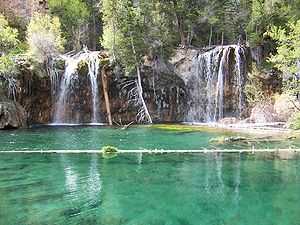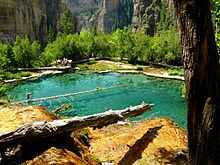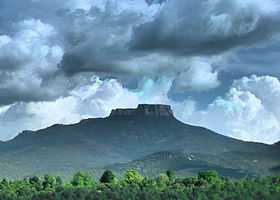List of National Natural Landmarks in Colorado

The National Natural Landmarks in Colorado include 14 of the almost 600 National Natural Landmarks (NNLs) in the United States; thirteen fully within Colorado and one shared with Wyoming. They cover areas of geological, biological and historical importance, and include lakes, mountains, rock formations and numerous fossil sites. The landmarks are located in 12 of the state's 64 counties. Four counties each contain all or part of two NNLs, while two landmarks are split between two counties. The first two designations, Slumgullion Earthflow and Summit Lake, were made in 1965, while the most recent designation, Big Spring Creek, was made in 2012.[1] Natural Landmarks in Colorado range from 60 to 380,000 acres (24.3 to 153,780.5 ha; 0.1 to 593.8 sq mi) in size. Owners include private individuals and several municipal, state and federal agencies.[2]
The National Natural Landmarks Program is administered by the National Park Service, a branch of the Department of the Interior. The National Park Service determines which properties meet NNL criteria and, after notifying the owners, makes nomination recommendations. The Secretary of the Interior reviews nominations and, based on a set of predetermined criteria, makes a decision on NNL designation or a determination of eligibility for designation. Both public and privately owned properties can be designated as NNLs. Owners may object to the nomination of the property as a NNL.[3] This designation provides indirect, partial protection of the historic integrity of the properties via tax incentives, grants, monitoring of threats, and other means.[4]
National Natural Landmarks
| Name | Image | Year | Location | County | Ownership | Description |
|---|---|---|---|---|---|---|
| Big Spring Creek | – |
2012 | 37°43′58″N 105°30′44″W / 37.732870°N 105.512120°W | Saguache | Federal | Unique spring-fed creek fed by an unconfined aquifer, creating a rare animal- and plant-supporting wetlands in a generally arid area.[5] |
| Garden of the Gods | |
1971 | 38°52′04″N 104°53′28″W / 38.8677690°N 104.8910877°W | El Paso | Municipal | The site showcases the lithologic character of sedimentary rocks, as well as providing a habitat for North American honey ants and excellent viewing opportunities for several bird species. |
| Garden Park Fossil Area | |
1973 | 38°34′24″N 105°13′31″W / 38.57333°N 105.22528°W | Fremont | Federal | Internationally recognized paleontological site renowned for finds of dinosaur, fish, crocodile, turtle and mammal fossils. In 2013, site was expanded from 40 to 3,200 acres (16.2 to 1,295.0 ha; 0.1 to 5.0 sq mi), and now includes five quarries where significant fossil finds have been made.[6] |
| Hanging Lake |  |
2011 | 39°36′06″N 107°11′31″W / 39.60165°N 107.191997°W | Garfield | Federal | Travertine deposition-formed lake with substantial hanging garden plant life and minimal human alteration, unique in the region.[7] |
| Indian Springs Trace Fossil |  |
1979 | 38°29′35.27″N 105°7′56.94″W / 38.4931306°N 105.1324833°W | Fremont | Private | Best North American location for animal trace fossils from the Ordovician era. |
| Lost Creek Scenic Area | – |
1966 | 39°16′7″N 105°28′5″W / 39.26861°N 105.46806°W | Park, Jefferson | Federal | Located in Pike National Forest, with extensive rock formations, including gorges, ridges and spires, and stream channels that meander between above- and under-ground. |
| Morrison-Golden Fossil Areas | |
1973 | 39°40′33″N 105°11′36″W / 39.6757°N 105.1934°W | Jefferson | County, private | Site of major paleontological importance, unique for fossil footprints of reptiles, birds, and mammals. The site was expanded in 2011 to include the 19 acres (7.7 ha; 0.0 sq mi) Golden Fossil Areas around the city of Golden.[8] |
| Raton Mesa |  |
1967 | 37°02′N 104°24′W / 37.033°N 104.400°W | Las Animas | State, private | Protected by a thick lava cap, Raton Mesa has resisted the extensive erosion and weathering that has affected surrounding areas, providing an extreme contrast in geography. |
| Roxborough State Park |  |
1980 | 39°25′47″N 105°04′09″W / 39.42972°N 105.06917°W | Douglas | State | Site showcases typical Colorado Front Range sedimentary strata, as well as erosion of Fountain Formation sandstone in unusual patterns, extensive fossil remains and unusual plant populations. |
| Russell Lakes | – |
1975 | 37°56′41″N 106°07′34″W / 37.94472°N 106.12611°W | Saguache | Federal, private | Colorado's largest remaining bulrush marsh, now rare in the southern Rocky Mountains. Provides habitat for extensive flora and fauna, especially waterfowl. |
| Sand Creek | – |
1984 | 40°59′49″N 105°46′14″W / 40.99694°N 105.77056°W | Larimer | Federal, state, private | Shared with Colorado, the site is one of North America's most impressive occurrences of cross-bedded sandstone and "topple blocks". Also a site of paleontological and biological significance. |
| Slumgullion Earthflow |  |
1965 | 37°59′30″N 107°15′25″W / 37.99167°N 107.25694°W | Hinsdale | Federal, private | A major example of the geologic process of mass wasting, a large flow of volcanic rock traveled from mountainside to valley to form Lake San Cristobal. The same process is occurring again, slowly covering the existing flow. |
| Spanish Peaks | |
1976 | 37°23′N 105°00′W / 37.38°N 105.0°W | Huerfano, Las Animas | Federal, private | Located in San Isabel National Forest, the site is an exceptional illustration of over 500 igneous dikes, many exposed, formed when molten igneous rock is forced into a fault before hardening. |
| Summit Lake |  |
1965 | 39°35′55″N 105°38′39″W / 39.59861°N 105.64417°W | Clear Creek | Municipal | At almost 13,000 feet (4,000 m), the site contains an excellent example of alpine tundra in the contiguous US. Some of the plants that survive in this microclimate are usually found only in the Arctic Circle. |
References
- General
- "National Registry of Natural Landmarks" (PDF). National Park Service. June 2009. pp. Introduction, 15–17. Retrieved 2014-01-06.
- Specific
- ↑ "National Registry of Natural Landmarks" (PDF). National Park Service. June 2009. pp. Introduction, 15–17. Retrieved 2013-08-02.
- ↑ "Colorado". National Park Service. June 28, 2012. Retrieved 2014-01-06.
- ↑ "36 CFR Part 62: National Natural Landmarks Program, Final Rule" (PDF). Federal Register. May 12, 1999. Retrieved 2013-08-02.
- ↑ "Frequently Asked Questions". National Park Service. Retrieved 2013-08-02.
- ↑ "Big Spring Creek". National Park Service. June 28, 2012. Retrieved 2014-01-06.
- ↑ "Spring 2013 Buds Two New NNLs and Expands an Existing Site". National Park Service. June 10, 2013. Retrieved 2014-01-06.
- ↑ "Hanging Lake". National Park Service. June 28, 2012. Retrieved 2014-01-06.
- ↑ "Secretary Salazar Designates New National Natural Landmarks". National Park Service. June 15, 2011. Retrieved 2014-01-07.